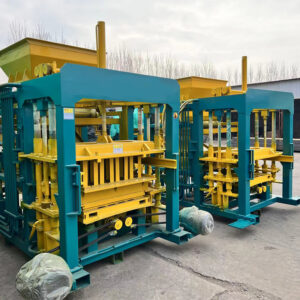
Image source :Aiweiblockmachine
Traceability and Transparency Boosted in Brick Making Equipment
Introduction
In an era defined by heightened awareness of environmental, ethical, and quality concerns, industries across the globe are embracing technologies that foster traceability and transparency. The construction sector, known for its intricate supply chains and diverse materials, is no exception. In recent years, the brick making industry has experienced a transformation fueled by the integration of advanced technologies that enhance traceability and transparency throughout the production process. This article delves into how traceability and transparency are being bolstered in brick making equipment, reshaping the construction landscape and paving the way for more responsible, accountable, and sustainable practices.
- The Imperative for Traceability and TransparencyIn a world where consumers and stakeholders demand accountability and sustainable practices, traceability and transparency have emerged as critical components of modern business operations. The construction industry, which traditionally struggled with opacity and complexity, is being pushed to adopt measures that ensure the provenance, quality, and ethical sourcing of materials.
- Traceability: From Source to Structure2.1 Material Origins and Sourcing
The integration of traceability mechanisms into brick making equipment allows manufacturers to accurately track the origins of raw materials. By providing detailed information about material sourcing, including location, suppliers, and ethical considerations, traceability systems enhance accountability and enable informed decision-making.
2.2 Supply Chain Monitoring
Traceability extends beyond raw materials, encompassing every step of the supply chain. From transportation and processing to storage and distribution, advanced tracking technologies provide real-time insights, reducing the risk of inefficiencies, delays, and unauthorized activities.
2.3 Product Lifecycle Tracking
Modern brick making equipment is equipped with sensors and digital tools that monitor a brick’s entire lifecycle, from production to installation and beyond. This comprehensive view supports sustainability initiatives by enabling efficient recycling, repurposing, or disposal of bricks at the end of their useful life.
- Transparency: Enabling Informed Decision-Making3.1 Real-Time Data Sharing
Transparency in brick making equipment involves the seamless sharing of data between manufacturers, suppliers, regulators, and end-users. Real-time access to data ensures that stakeholders are well-informed about the production process, material properties, and project timelines.
3.2 Quality Assurance and Standards
Transparent processes facilitate adherence to quality standards and regulations. Manufacturers can provide detailed information about production practices, testing procedures, and compliance with industry-specific norms, ensuring that bricks meet the required specifications.
3.3 Project Visibility for Stakeholders
Transparency extends to construction projects, where stakeholders can access real-time updates on brick deliveries, installation progress, and any deviations from the original plan. This transparency enhances collaboration, reduces misunderstandings, and enables timely adjustments.
- Technological Enablers of Traceability and Transparency4.1 Internet of Things (IoT) Integration
IoT sensors embedded in brick making equipment collect and transmit data about temperature, humidity, production rates, and material characteristics. This data-rich environment enhances traceability and transparency by providing accurate insights into every stage of production.
4.2 Blockchain Technology
Blockchain’s decentralized and tamper-proof nature makes it an ideal platform for recording and sharing data across the brick manufacturing ecosystem. It ensures the immutability of information, fostering trust and transparency among all stakeholders.
4.3 Cloud-Based Platforms
Cloud-based platforms enable seamless sharing of data, allowing manufacturers, suppliers, and construction teams to access information from anywhere, fostering collaboration and transparency.
- Benefits and Impact on the Industry5.1 Improved Quality Control
Traceability and transparency empower manufacturers to identify and address quality issues promptly, resulting in higher-quality bricks and reduced wastage.
5.2 Ethical Sourcing and Sustainability
Consumers and regulators increasingly demand ethically sourced materials. Traceability ensures that bricks are produced using responsible practices, minimizing environmental and social impacts.
5.3 Streamlined Compliance
The ability to demonstrate adherence to regulations and standards enhances a manufacturer’s reputation and credibility, paving the way for better market positioning.
- Challenges and Future Outlook6.1 Data Security and Privacy
As traceability and transparency rely on data sharing, ensuring the security and privacy of sensitive information remains a paramount concern.
6.2 Adoption and Integration
Brick manufacturers may encounter challenges when integrating traceability and transparency technologies into existing processes. Education, training, and gradual implementation are key to overcoming these hurdles.
- Case Studies: Successful Implementation of Traceability and Transparency7.1 Brickchain: Reinventing Accountability
A blockchain-based platform, Brickchain, has revolutionized traceability and transparency in the brick making industry, connecting stakeholders and ensuring accountability from source to structure.
7.2 Eco-Friendly Brick Tracking in Sweden
Swedish brick manufacturers are utilizing IoT sensors and cloud-based platforms to provide real-time information about the sustainability and environmental impact of their bricks.
- ConclusionTraceability and transparency are more than industry buzzwords; they are essential elements driving the transformation of the brick making industry. As the construction sector embraces these technologies, manufacturers, regulators, and consumers are collaboratively shaping a future where responsible and sustainable practices are the norm. By leveraging advanced brick making equipment and innovative tracking technologies, the industry is building not only structures but also a foundation of trust, accountability, and environmental stewardship.
- https://youtu.be/BLtJK_hVxDo
